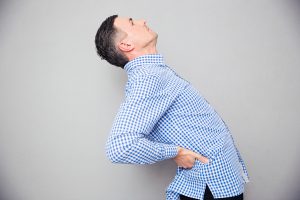How exercise improves posture and pain relief

One of the most common complaints I hear of is back pain, mostly lower back occasionally upper back between the shoulder blades. This can be due to a number of things: poor posture, weak or untrained back and core muscles, being slumped over a desk staring at a computer screen is a firm favourite too.
Being aware of your posture is probably a good place to start, if sitting for any amount of time, try and think of your spine as being a stack of bricks, with each brick representing a vertebra, each one sitting vertically over the other and each making a line over your tailbone or coccyx. You may need to adjust the viewing angle of your screen as you will most likely be further away and more upright.
Core strength, particularly lower back, may be another contributory factor. Muscles in the lower back are often forgotten and can lead to painful spasms if abused or misaligned through historical poor posture. Targeted exercises for lower back strength such as deadlifts, back hyperextenstions, dorsal raises and kettle bell swings are excellent ways of building lower back strength.
Abdominal core strength can be improved using exercises like crunches, when carried out properly, they can really improve upper abdominal strength. For lower abdominal strength, exercises like leg raises or reverse crunches really work the lower abdominal muscles and deeper core muscles the Transverse Abdominis.
So how does exercise relieve pain? Well when you exercise for around 30 mins chemicals are activated in the brain, that give you a sense of euphoria, a feel good factor. These chemicals, namely endorphins also affect the pain receptors in the brain, kind of switching them off so any pain induced through training or previous to training will be reduced for a period of time. Once you have finished and possibly a few hours or days after, the pain may re-occur. If you experience pain after training, especially with weights, this is normal and will subside after a few days. This pain is known as delayed onset of muscle soreness or DOMS. It is thought to be the process of muscle tissues repairing and rebuilding, no pain no gain, as someone famously said!
